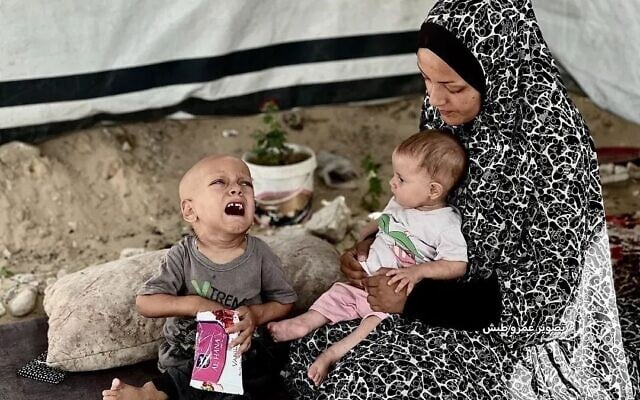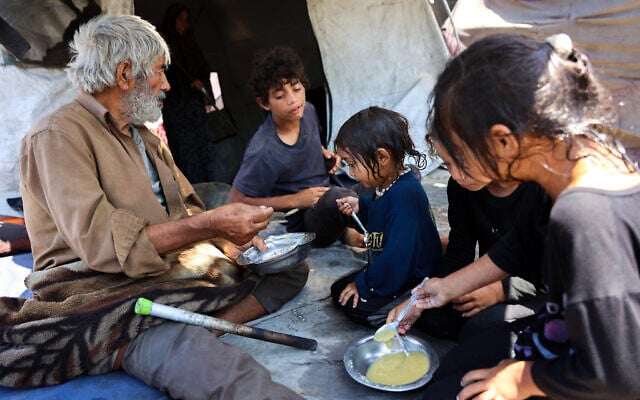



Hamas has been inflating the toll of Palestinians it says have died of malnutrition, and most of those verified to have died had preexisting medical conditions, Israel’s Coordinator of Government Activities in the Territories (COGAT) asserted on Tuesday.
COGAT said Israeli security officials and medical experts had conducted a review of Hamas’s starvation claims in Gaza and found that the terror group has conducted “an orchestrated campaign as part of a broader effort to discredit the State of Israel and achieve political gains.”
“The thorough review found a significant gap between the number of deaths attributed to malnutrition as reported by Hamas’s health ministry and the cases documented and published with full identifying details,” COGAT said, including in media and on social networks.
From the beginning of the war until June 2025, the Hamas-run ministry reported 66 deaths due to alleged starvation. Then, in July 2025, it reported over 133 such deaths.
“Despite the allegedly high death toll in July, Hamas’s health ministry did not release the identities of the deceased as it had done in the past,” COGAT charged.
The Defense Ministry body said that on July 19, Hamas announced 18 deaths from starvation, and on July 22, another 15. “However, an in-depth review of various platforms identified only a handful of actual cases. This discrepancy between the numerical reports and the individual publications raises doubts about their credibility,” it said.
“The case-by-case analysis of the published deaths shows that most of those allegedly dying from malnutrition had preexisting medical conditions that led to the deterioration of their health, unrelated to their nutritional status,” COGAT claimed. “It was also found that some had even received medical treatment in Israel before the war. This indicates that the documented cases do not represent the condition of the general population in the Gaza Strip but rather selectively present extreme cases involving preexisting illnesses.”
COGAT noted that in recent weeks, images circulated online of an emaciated four-year-old, Abdullah Hani Muhammad Abu Zarqa, who was claimed to have been suffering from starvation. “A COGAT review found that he suffers from a genetic disease causing vitamin and mineral deficiencies, osteoporosis, and bone thinning, a hereditary illness that also affected other family members. It was further established that four months before the outbreak of the war, the child traveled with his mother, with Israeli approval, to receive medical treatment at Al-Makassed Hospital in East Jerusalem,” the statement said.
Another case noted by COGAT was that of 27-year-old Karam Khaled Mustafa al-Jamal, who was reported to have died from starvation. “The defense establishment determined that Karam had suffered since childhood from muscular dystrophy and partial paralysis, which caused swallowing difficulties. This was a longstanding medical condition unrelated to the general nutritional situation in Gaza,” COGAT said.
COGAT said that the review, “including by analyzing broader photographic evidence and other available intelligence, concluded that there are no signs of a widespread malnutrition phenomenon among the population in Gaza.”
“The Hamas terrorist organization cynically exploits tragic images and misuses them for a false and timed propaganda campaign aimed at generating pressure and creating negative public opinion against the State of Israel,” COGAT said, adding that it will “continue working to improve the humanitarian response in the Gaza Strip, in cooperation with the international community, while rejecting allegations of famine in the Gaza Strip.”
COGAT did not release the full review to the public.
While Israeli officials say many of those who died while malnourished in Gaza were suffering from preexisting illnesses, famine experts say this is typical in the early stages of a hunger crisis.
Israel denies the allegations of widespread starvation and has said it makes efforts to allow sufficient aid into Gaza. But facing heavy international pressure, the government recently greatly increased the flow of supplies, after having barred aid altogether for 11 weeks between March and May.
Israel has endorsed the controversial new Gaza Humanitarian Foundation (GHF) mechanism for its distribution, has blamed Hamas for disrupting food distribution, and has pointed to hundreds of trucks’ worth of aid waiting inside Gaza to be distributed. The UN has repeatedly claimed that COGAT has refused requests to authorize collection and distribution, and that dangerous and complex conditions inside Gaza, including hungry crowds and gangs, made aid distribution very difficult.
The UN — which has refused to work with GHF, saying it violates humanitarian principles — has said more than 1,000 people have been killed near aid distribution centers since May, many of them at GHF sites. Israel says those figures are inflated, though it has acknowledged firing “warning shots” at people who approached troops in a manner it says endangered them. It has not provided alternative numbers.
The war in Gaza began on October 7, 2023, when thousands of Hamas-led terrorists invaded southern Israel, killing some 1,200 people and taking 251 hostages, of whom 49 are still held, among whom 20 are believed to be alive. Hamas is also holding the body of an IDF soldier killed in Gaza in 2014.
Agencies and Times of Israel staff contributed to this report.


